Page 1887 of 3419
EI-26
REAR SPOILER
Revision: October 20052005 QX56
REAR SPOILERPFP:96030
Removal and InstallationEIS004WM
REMOVAL
1. Remove back door trim. Refer to EI-42, "BACK DOOR TRIM" .
2. Disconnect harness to high-mount stop lamp.
3. Disconnect washer tube.
4. Remove nuts, release clips and remove rear spoiler.
�Release adhesive tape with sawing motion from monofilament line that has knots in it.
�Remove residue of adhesive tape completely from vehicle surface with strip-off wheel or equivalent.
CAUTION:
�Never apply tack-paper adhesive remover to body panel surface finished with lacquer-based
paints.
�Use care not to damage the vehicle surface during adhesive tape residue removal.
5. Remove nuts and remove high-mount stop lamp.
INSTALLATION
Installation is in the reverse order of removal.
NOTE:
Apply adhesion promoter only to areas of rear spoiler that tape will be applied, as required.
1. Grommet 2. Plastic clip 3. Nut
4. Rear air spoiler 5. High-mount stop lamp
WIIA0592E
Page 1972 of 3419
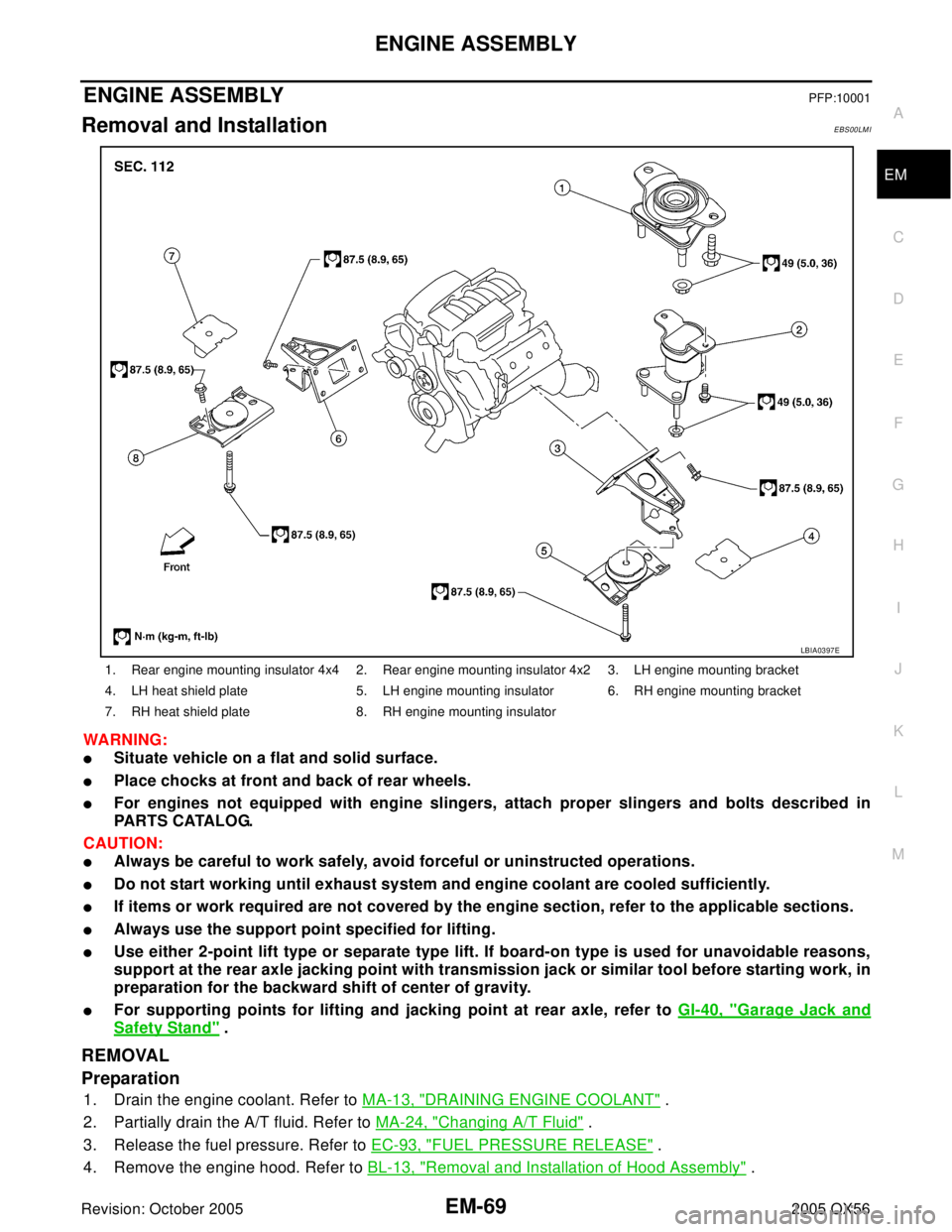
ENGINE ASSEMBLY
EM-69
C
D
E
F
G
H
I
J
K
L
MA
EM
Revision: October 20052005 QX56
ENGINE ASSEMBLYPFP:10001
Removal and InstallationEBS00LMI
WA RN ING:
�Situate vehicle on a flat and solid surface.
�Place chocks at front and back of rear wheels.
�For engines not equipped with engine slingers, attach proper slingers and bolts described in
PA R T S C ATA L O G.
CAUTION:
�Always be careful to work safely, avoid forceful or uninstructed operations.
�Do not start working until exhaust system and engine coolant are cooled sufficiently.
�If items or work required are not covered by the engine section, refer to the applicable sections.
�Always use the support point specified for lifting.
�Use either 2-point lift type or separate type lift. If board-on type is used for unavoidable reasons,
support at the rear axle jacking point with transmission jack or similar tool before starting work, in
preparation for the backward shift of center of gravity.
�For supporting points for lifting and jacking point at rear axle, refer to GI-40, "Garage Jack and
Safety Stand" .
REMOVAL
Preparation
1. Drain the engine coolant. Refer to MA-13, "DRAINING ENGINE COOLANT" .
2. Partially drain the A/T fluid. Refer to MA-24, "
Changing A/T Fluid" .
3. Release the fuel pressure. Refer to EC-93, "
FUEL PRESSURE RELEASE" .
4. Remove the engine hood. Refer to BL-13, "
Removal and Installation of Hood Assembly" .
1. Rear engine mounting insulator 4x4 2. Rear engine mounting insulator 4x2 3. LH engine mounting bracket
4. LH heat shield plate 5. LH engine mounting insulator 6. RH engine mounting bracket
7. RH heat shield plate 8. RH engine mounting insulator
LBIA0397E
Page 2018 of 3419
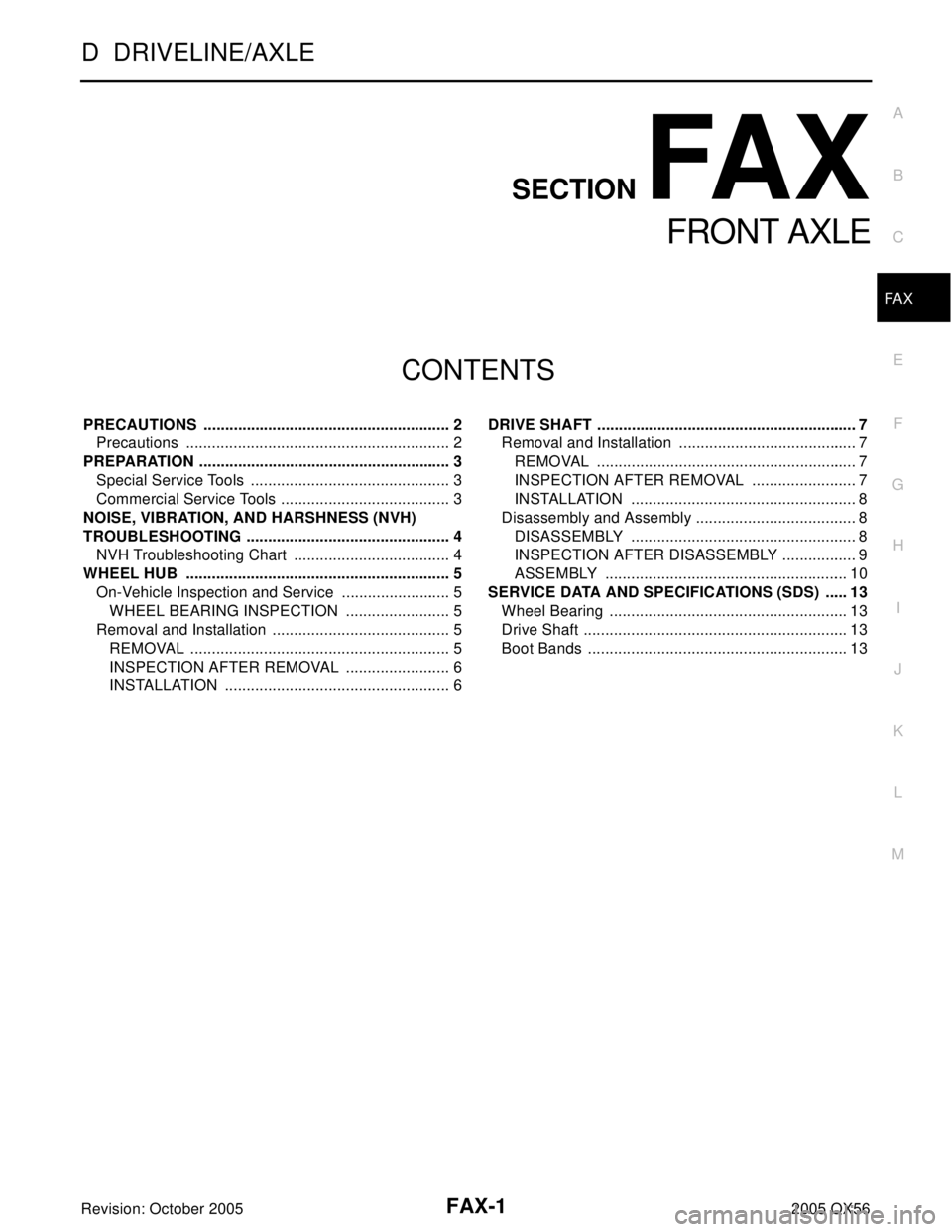
FAX-1
FRONT AXLE
D DRIVELINE/AXLE
CONTENTS
C
E
F
G
H
I
J
K
L
M
SECTION FA X
A
B
FA X
Revision: October 20052005 QX56 PRECAUTIONS .......................................................... 2
Precautions .............................................................. 2
PREPARATION ........................................................... 3
Special Service Tools ............................................... 3
Commercial Service Tools ........................................ 3
NOISE, VIBRATION, AND HARSHNESS (NVH)
TROUBLESHOOTING ................................................ 4
NVH Troubleshooting Chart ..................................... 4
WHEEL HUB .............................................................. 5
On-Vehicle Inspection and Service .......................... 5
WHEEL BEARING INSPECTION ......................... 5
Removal and Installation .......................................... 5
REMOVAL ............................................................. 5
INSPECTION AFTER REMOVAL ......................... 6
INSTALLATION ..................................................... 6DRIVE SHAFT ............................................................. 7
Removal and Installation .......................................... 7
REMOVAL ............................................................. 7
INSPECTION AFTER REMOVAL ......................... 7
INSTALLATION ..................................................... 8
Disassembly and Assembly ...................................... 8
DISASSEMBLY ..................................................... 8
INSPECTION AFTER DISASSEMBLY .................. 9
ASSEMBLY ......................................................... 10
SERVICE DATA AND SPECIFICATIONS (SDS) ...... 13
Wheel Bearing ........................................................ 13
Drive Shaft .............................................................. 13
Boot Bands ............................................................. 13
Page 2019 of 3419
FAX-2
PRECAUTIONS
Revision: October 20052005 QX56
PRECAUTIONSPFP:00001
PrecautionsEDS001X9
Observe the following precautions when disassembling and servicing the wheel hub and drive shafts.
�Perform work in a location which is as dust-free as possible.
�Before disassembling and servicing, clean the outside of parts.
�Prevention of the entry of foreign objects must be taken into account during disassembly of the compo-
nent parts.
�Disassembled parts must be carefully reassembled in the correct order. If work is interrupted, a clean
cover must be placed over parts.
�Paper shop cloths must be used. Fabric shop cloths must not be used because of the danger of lint adher-
ing to parts.
�Disassembled parts (except for rubber parts) should be cleaned with a suitable solvent which shall be
removed by blowing with air or wiping with paper shop cloths.
Page 2021 of 3419
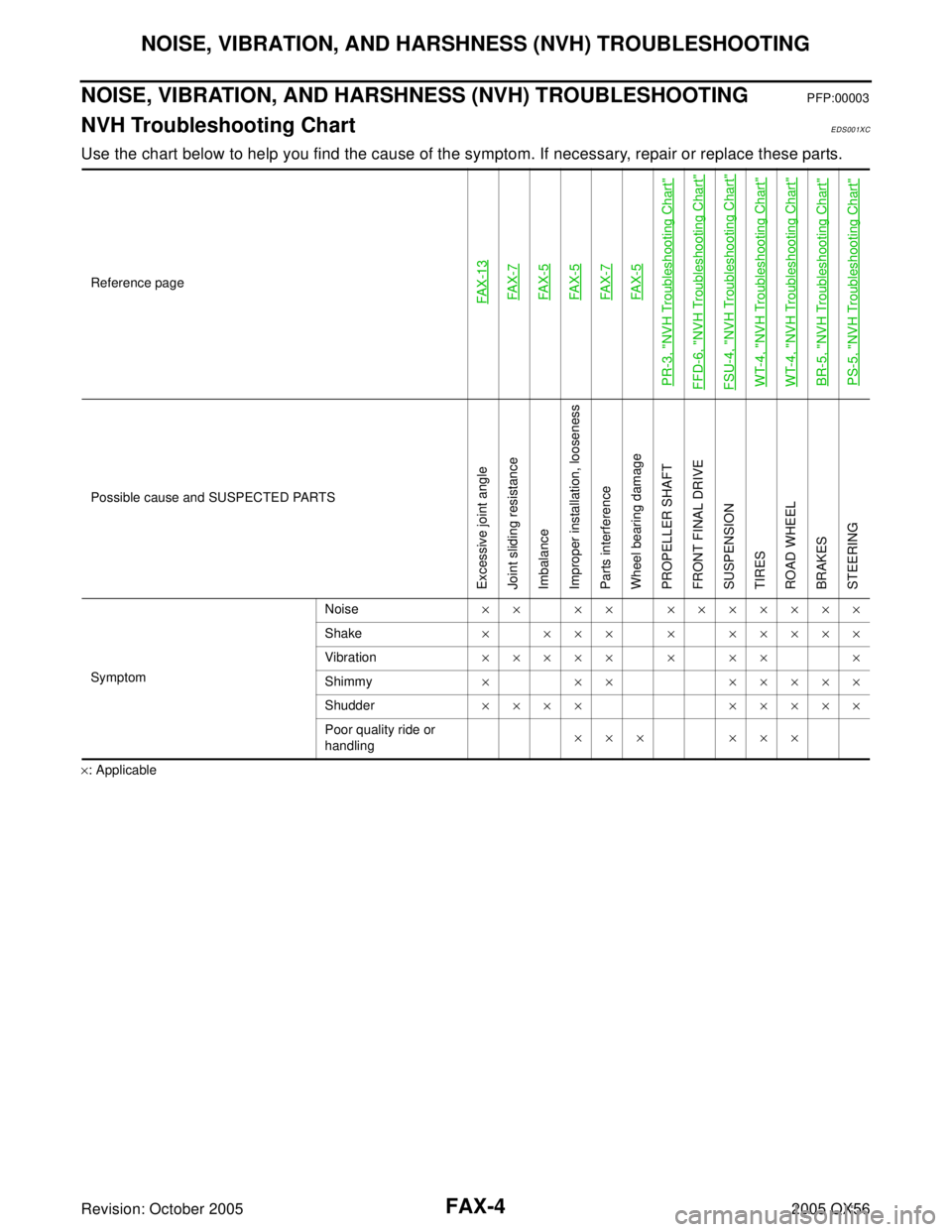
FAX-4
NOISE, VIBRATION, AND HARSHNESS (NVH) TROUBLESHOOTING
Revision: October 20052005 QX56
NOISE, VIBRATION, AND HARSHNESS (NVH) TROUBLESHOOTINGPFP:00003
NVH Troubleshooting ChartEDS001XC
Use the chart below to help you find the cause of the symptom. If necessary, repair or replace these parts.
×: ApplicableReference page
FAX -1 3FA X - 7FA X - 5FA X - 5FA X - 7FA X - 5
PR-3, "
NVH Troubleshooting Chart
"
FFD-6, "
NVH Troubleshooting Chart
"
FSU-4, "
NVH Troubleshooting Chart
"
WT-4, "
NVH Troubleshooting Chart
"
WT-4, "
NVH Troubleshooting Chart
"
BR-5, "
NVH Troubleshooting Chart
"
PS-5, "
NVH Troubleshooting Chart
"
Possible cause and SUSPECTED PARTS
Excessive joint angle
Joint sliding resistance
Imbalance
Improper installation, looseness
Parts interference
Wheel bearing damage
PROPELLER SHAFT
FRONT FINAL DRIVE
SUSPENSION
TIRES
ROAD WHEEL
BRAKES
STEERING
SymptomNoise×× ×× ×××××××
Shake× ××× × ×××××
Vibration××××× × ×× ×
Shimmy× ×× ×××××
Shudder×××× ×××××
Poor quality ride or
handling××× ×××
Page 2022 of 3419
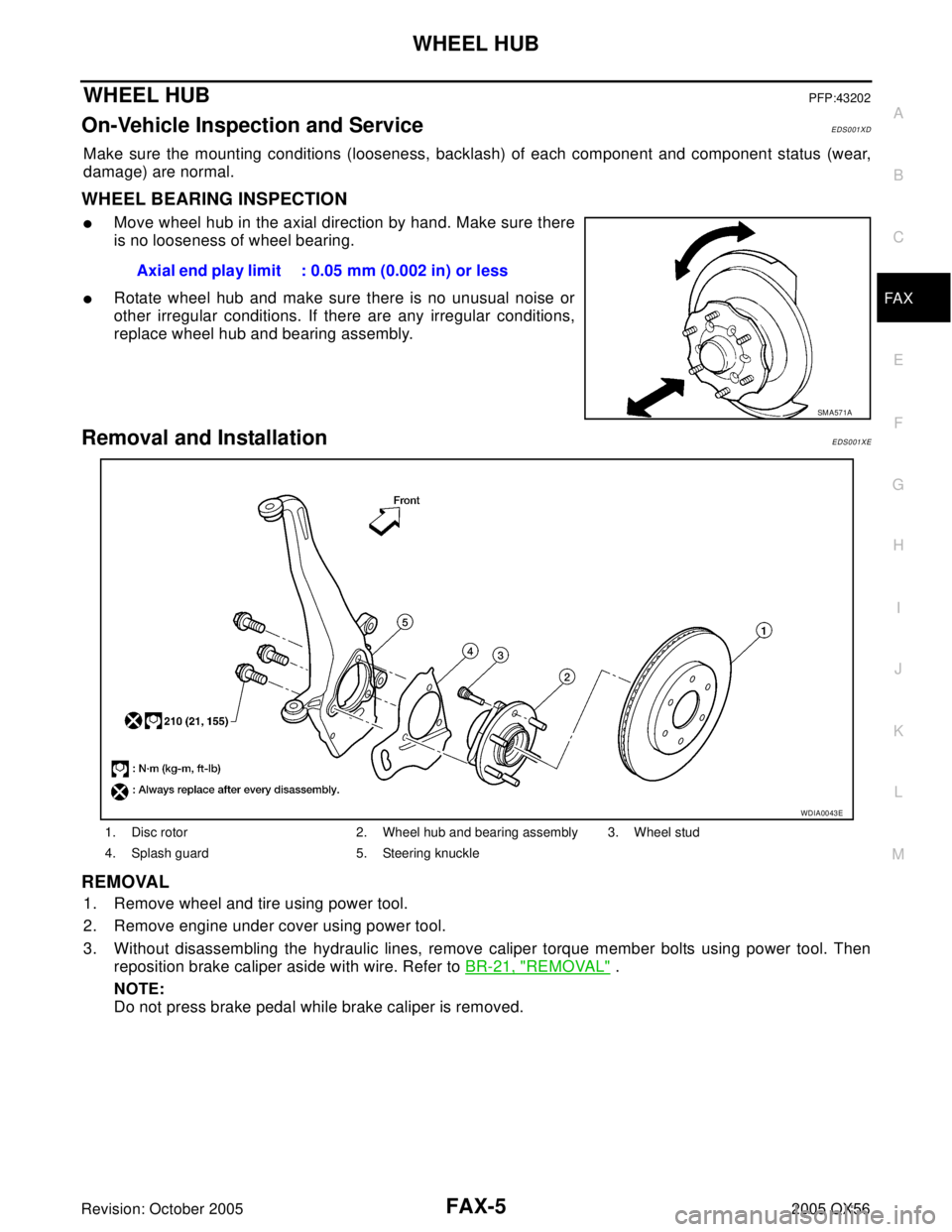
WHEEL HUB
FAX-5
C
E
F
G
H
I
J
K
L
MA
B
FA X
Revision: October 20052005 QX56
WHEEL HUBPFP:43202
On-Vehicle Inspection and ServiceEDS001XD
Make sure the mounting conditions (looseness, backlash) of each component and component status (wear,
damage) are normal.
WHEEL BEARING INSPECTION
�Move wheel hub in the axial direction by hand. Make sure there
is no looseness of wheel bearing.
�Rotate wheel hub and make sure there is no unusual noise or
other irregular conditions. If there are any irregular conditions,
replace wheel hub and bearing assembly.
Removal and InstallationEDS001XE
REMOVAL
1. Remove wheel and tire using power tool.
2. Remove engine under cover using power tool.
3. Without disassembling the hydraulic lines, remove caliper torque member bolts using power tool. Then
reposition brake caliper aside with wire. Refer to BR-21, "
REMOVAL" .
NOTE:
Do not press brake pedal while brake caliper is removed.Axial end play limit : 0.05 mm (0.002 in) or less
SM A57 1A
1. Disc rotor 2. Wheel hub and bearing assembly 3. Wheel stud
4. Splash guard 5. Steering knuckle
WDIA0043E
Page 2023 of 3419
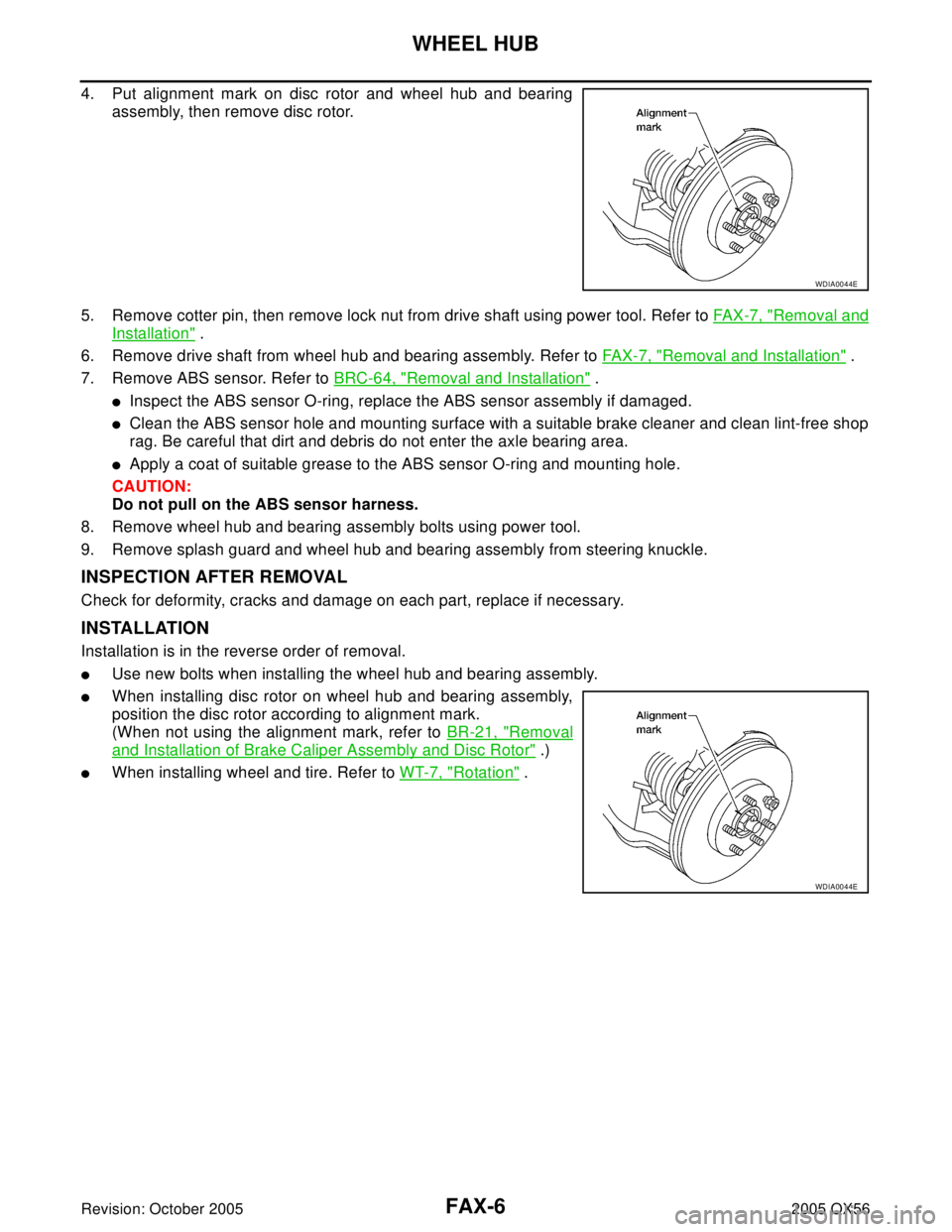
FAX-6
WHEEL HUB
Revision: October 20052005 QX56
4. Put alignment mark on disc rotor and wheel hub and bearing
assembly, then remove disc rotor.
5. Remove cotter pin, then remove lock nut from drive shaft using power tool. Refer to FA X -7 , "
Removal and
Installation" .
6. Remove drive shaft from wheel hub and bearing assembly. Refer to FAX-7, "
Removal and Installation" .
7. Remove ABS sensor. Refer to BRC-64, "
Removal and Installation" .
�Inspect the ABS sensor O-ring, replace the ABS sensor assembly if damaged.
�Clean the ABS sensor hole and mounting surface with a suitable brake cleaner and clean lint-free shop
rag. Be careful that dirt and debris do not enter the axle bearing area.
�Apply a coat of suitable grease to the ABS sensor O-ring and mounting hole.
CAUTION:
Do not pull on the ABS sensor harness.
8. Remove wheel hub and bearing assembly bolts using power tool.
9. Remove splash guard and wheel hub and bearing assembly from steering knuckle.
INSPECTION AFTER REMOVAL
Check for deformity, cracks and damage on each part, replace if necessary.
INSTALLATION
Installation is in the reverse order of removal.
�Use new bolts when installing the wheel hub and bearing assembly.
�When installing disc rotor on wheel hub and bearing assembly,
position the disc rotor according to alignment mark.
(When not using the alignment mark, refer to BR-21, "
Removal
and Installation of Brake Caliper Assembly and Disc Rotor" .)
�When installing wheel and tire. Refer to WT-7, "Rotation" .
WDIA0044E
WDIA0044E
Page 2024 of 3419
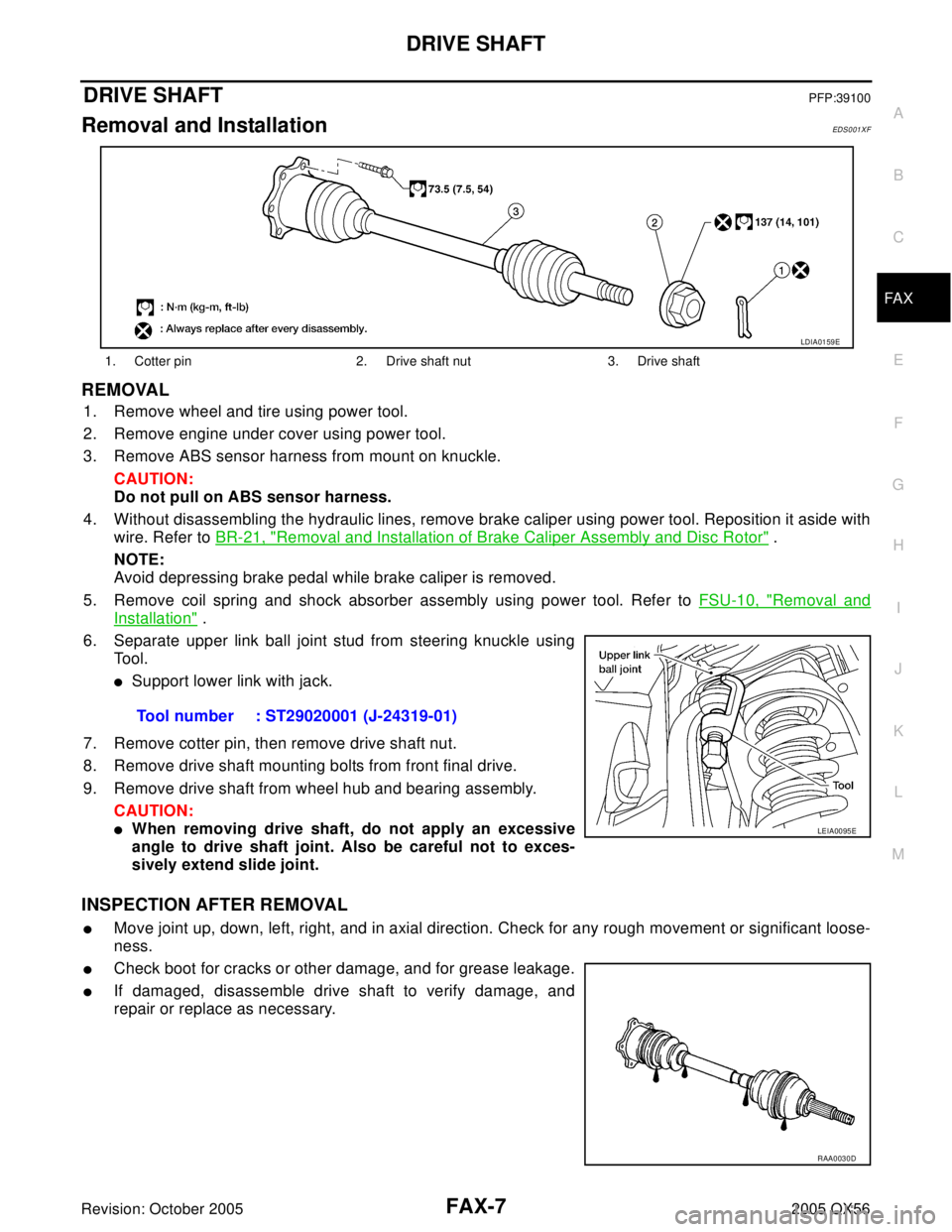
DRIVE SHAFT
FAX-7
C
E
F
G
H
I
J
K
L
MA
B
FA X
Revision: October 20052005 QX56
DRIVE SHAFTPFP:39100
Removal and InstallationEDS001XF
REMOVAL
1. Remove wheel and tire using power tool.
2. Remove engine under cover using power tool.
3. Remove ABS sensor harness from mount on knuckle.
CAUTION:
Do not pull on ABS sensor harness.
4. Without disassembling the hydraulic lines, remove brake caliper using power tool. Reposition it aside with
wire. Refer to BR-21, "
Removal and Installation of Brake Caliper Assembly and Disc Rotor" .
NOTE:
Avoid depressing brake pedal while brake caliper is removed.
5. Remove coil spring and shock absorber assembly using power tool. Refer to FSU-10, "
Removal and
Installation" .
6. Separate upper link ball joint stud from steering knuckle using
Tool.
�Support lower link with jack.
7. Remove cotter pin, then remove drive shaft nut.
8. Remove drive shaft mounting bolts from front final drive.
9. Remove drive shaft from wheel hub and bearing assembly.
CAUTION:
�When removing drive shaft, do not apply an excessive
angle to drive shaft joint. Also be careful not to exces-
sively extend slide joint.
INSPECTION AFTER REMOVAL
�Move joint up, down, left, right, and in axial direction. Check for any rough movement or significant loose-
ness.
�Check boot for cracks or other damage, and for grease leakage.
�If damaged, disassemble drive shaft to verify damage, and
repair or replace as necessary.
1. Cotter pin 2. Drive shaft nut 3. Drive shaft
LDIA0159E
Tool number : ST29020001 (J-24319-01)
LEIA0095E
RAA0030D